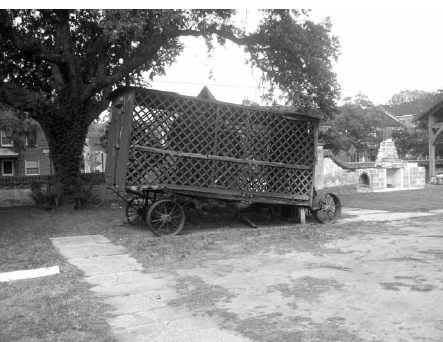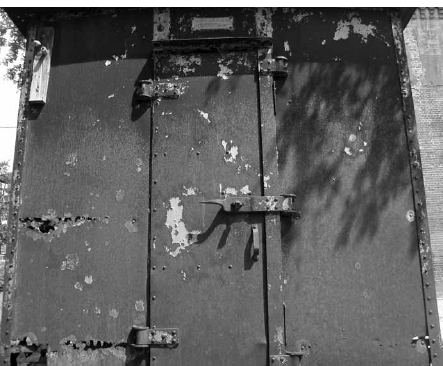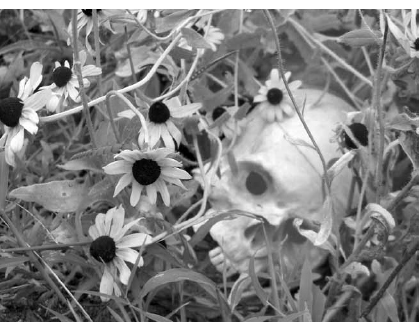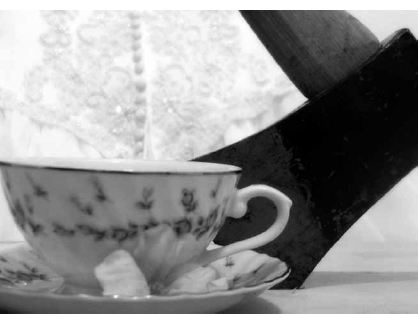Six Miles to Charleston (6 page)
Read Six Miles to Charleston Online
Authors: Bruce Orr

Paddy wagon used to transport prisoners in Charleston. The open cage allowed objects to be thrown at prisoners by spectators.
Courtesy of author.

The Fishers' introduction to colonial justice began at the rear entry to the paddy wagon.
Courtesy of author.
This story is quite a different one from the legend. The statements of both victims have been furnished in their entirety just as they were written. There are no accounts of trapdoors, poisoned tea or a cellar full of skeletons. In fact, quite a lot of research went into trying to document the numerous bodies alleged to have been uncovered in the cellar. Legend has it that the cellar was uncovered in June 1819 and that numerous skeletal remains were found. A member of the gang, William Heyward, would later be captured and hanged in August 1820. His charges did not reflect the fact that numerous bodies had been located. Surely with a year and two months' time since this alleged gruesome discovery, the murders would have reached the media and been reflected in the charges against Mr. Heyward. That never happened, and the reason that it never happened is because the story of a cellar full of corpses, just like the oleander poisoned tea, is fabrication and fiction.
A search of the death records of 1819 and 1820 found no such evidence of a mass grave of skeletal remains. No records at all were found even remotely similar to this claim. What was found was an article in the
Charleston Courier
dated February 26, 1819, less than a week after the arrests. It is the only account of bodies contributed or associated with the Six Mile House.
The coroner for the Charleston district was Jervis H. Stevens. He had received information that a fresh grave was found in the woods near the Six Mile House. It was believed that the gang of robbers had buried a man there approximately ten days prior to his receipt of the information. The man had been reported to have been shot to death.
Coroner Stevens went to the location, and during his search, he did indeed locate a fresh grave. Much to his surprise, the excavation of the gravesite revealed not one, but two bodies. The first appeared to have long hair and to be a white male buried in a box made of rough slabs. The other body, which had been located buried beside the first, appeared to be the remains of a young Negro female. The remains of the woman were alleged to have been placed in the grave two years prior. Nothing remained of her but her skeleton. She is the only skeleton associated with Six Mile House. She was not discovered in a cellar. She was simply buried on the property in an unmarked grave, not at all uncommon for slaves in 1819. Today we may find this appalling, but in 1819, this was a daily occurrence.
No one was ever charged with either of these deaths. In fact, the person shot was never attributed to being a victim of any crime at all. Could perhaps he had been a member of the gang who was mortally wounded in a self-defense act by a potential robbery victim? More than likely he was killed in the assault on the Five Mile House or the initial assault on the Six Mile House by the lynch mob. He may have been the missing “F. Davis” or William Andrews listed on Peoples's affidavit.
The
Charleston Courier
article states that the person was said to have been shot about ten days prior. This was February 26. The raids on the Five Mile House and the Six Mile House had occurred on February 18, eight days earlier, putting it in the same time frame. It is highly possible this man was killed in the assault upon the Five Mile House since there was resistance and it was burned to the ground that night in order to drive those occupants out.
The report of the bodies in the
Charleston Courier
is directly below a report of the arrest of John Smith and Joseph Roberts in regard to the gang. It is most likely that the information of the corpses came from them. Since neither Smith nor Roberts was charged with murder, one can assume that the man in the grave may have been in allegiance with the gang and not their victim.

The body count is greatly exaggerated in the legend. In fact, no murders were ever attributed to the Fishers.
Courtesy of author.

The oleander tea, the dismembered bodies and even the wedding dress have no basis in fact.
Courtesy of Kayla Orr.
As the legend has it, the numerous skeletal remains and decomposing corpses had been located in a cellar under the house. Now as far as cellars in Charleston, Charleston is below sea level and has constant drainage and flooding issues. It did then and does continue to have them to this day. That being said, it does not mean that there were none, but the likelihood of a colonial cellar in the area where the Six Mile House stood even on the outskirts of the city is extremely unlikely.
During this time, beer cellars were popular in European countries and used to store kegs and casks of beer and keep them cool. There was, of course, no refrigeration. A below-ground cellar such as a root cellar or a beer cellar most probably would not have existed in the Charleston area.
Most beer cellars in the Charleston area were storage areas above ground and directly under the first floor of the home. The homes that had them were elevated to allow such areas. Had there been a multitude of decaying corpses above ground or even shallowly buried under the home, the smell would have been unbearable. The presence of one rotting corpse in the Charleston summer is not pleasant. A multitude of decaying corpses would be horrendous. Someone would have surely noticed. That is exactly what led to the apprehension of serial killer John Wayne Gacy and the location of the thirty-three decaying corpses he had stuffed in his crawl space and the additional three buried in shallow graves in his yard. The smell just has a way of giving those things away. If Lavinia and John Fisher had murdered that many people, there would have been reports made, and the papers would have reported such disappearances. Again, none were found.
The tale of multiple corpses can be attributed to Peter Neilson. Peter Neilson, a Scot, claimed to have been in Charleston in 1820 when the Fisher ordeal reached its climax. He wrote a book, published in 1830, in which he stated that the Six Mile House gang “had for years carried on a complete trade of murdering and robbing altogether unheard of, except perhaps in Italy in former times.” He goes on, further stating, “On digging around this den of iniquity, a great number of skeletons were found, no doubt the remains of unfortunate travelers.”
Mr. Neilson would have been familiar with beer cellars in his own homeland. He possibly attributed this “writer's embellishment” to the Six Mile House tavern. His book was ten years after the fact and one begins to question why he would wait so long to report such a horrific find unless he was waiting on the facts to fade and the fantastic to be embraced. Perhaps the real answer lies in what would become known as the “Penny Dreadful.”
In the nineteenth century, publications known as Penny Dreadfuls circulated Europe. They were cheap, thus the name. They were also sensational fictional works or overexaggerations of actual events. Our Scottish friend Peter Neilson appears to have been author of such. That would have made it 1830 if he waited ten years after the events. This was actually the height of popularity for these cheap stories. He can be attributed as the direct source of the excessive body count. His Penny Dreadful account of the Fishers boosted their villainy as much as the dime novels in the later 1800s did for outlaws such as Billy the Kid.
With the legend raising the number of victims to incredible levels, Lavinia Fisher is often referred to as America's first female serial killer. From the facts gathered, she does not fit the criteria. The Behavioral Science Unit of the FBI was created by Agent Roy Hazelwood and a handful of others. He was one of the original serial profilers and instrumental in creating the definition of what a serial killer is. It is the FBI who defines the criteria for a person to be identified as a serial killer, and that definition is a person who murders three or more people over a period of more than thirty days with a cooling-off period between each murder. Neither of the two corpses was ever proven to be a victim of anything the Fishers are accused of. The two bodies were never criminally connected with Lavinia Fisher or John Fisher at all. Even if they had been, that is still only two corpses, one less than the definition requires, unless you count the LaCoste cow found in the outhouse.
C
HAPTER
3
The Gang
T
HE
F
ORGOTTEN
M
EMBERS
A stay in the City Jail, no matter how brief, was not a pleasant one. The City Jail, or as it was referred to back then, “The Gaol,” was built in 1802 to replace the Provost Dungeon. It was built over a potter's field cemetery of slaves, vagrants and derelicts. A jail that was built to hold approximately 130 people often held 300 or more. The ancient building has often been described more as a place of torture rather than a jail or correctional facility. One estimate places the deaths at this location in the area of 10,000 or more. Whippings, beatings, physical assaults and sexual assaults were commonplace, and that was with the jailers (or gaolers as they were called) and prisoners alike. The bars on the windows did little to keep out the bone-chilling cold of Charleston's winters or the stifling heat and humidity of the city's summers. It also did little to keep out the insects and rodents that infested the city.
In early times, the most dangerous of the prisoners were secured by being chained to a large ring in the center of the floor. These would be your violent offenders and your escape risks. This also would be the method for securing the severely mentally ill since the jail also served as an insane asylum. In later years, prisoners were kept seven or eight to a cage with a multitude of cages being kept on each floor. There was no separation of the sexes unless the guards removed the females for their own personal entertainment.
There was no running water within the building, so therefore sanitary conditions were deplorable. Within the jail, wood chips were scattered on the floor. That was the prisoner's bedding and quite often their toilet. Occasionally the chips would be changed, but not often. If you had suffered at the hands of your tormentors, you were returned to your cell and your open wounds were exposed to the filth of your living conditions. Infection and disease were rampant. What manners of death that were not created by infection, brought in from the harbor, blown in through the windows, carried in by the rats or dealt by the captors was often carried out by the prisoners upon themselves. Suicide was often a preferable fate.